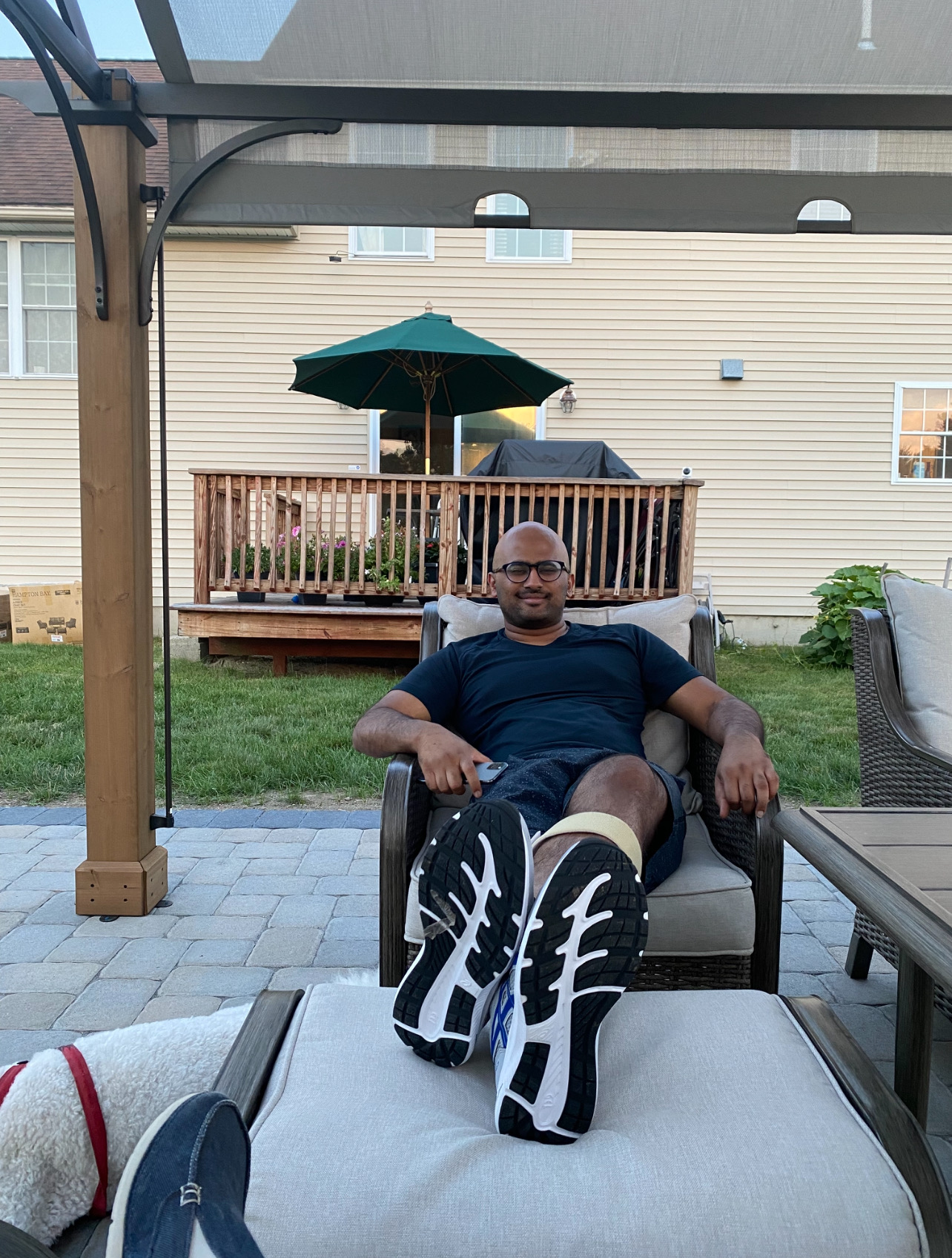Finding Hope In New Approach to Diagnosing Brain Tumors
- Liquid biopsies test body fluid in search of cancer or tumor cells in the DNA of a patient.
- Targeted Rapid Sequencing (TetRS) is an approach to liquid biopsies that eliminates the need for invasive surgical brain biopsy, which involves collecting tissue samples. Instead, it analyzes the cerebrospinal fluid, which also covers the brain, with a simple lumbar puncture procedure.
- The benefits of TetRS compared to the gold standard of tissue sampling are that test results can come back in minutes rather than roughly two weeks. It looks for genetic markers that can signal brain cancer, and faster test results can mean more immediate treatment.
A 31-year-old Massachusetts man living with a cancerous brain tumor is taking back control of his life after once losing the ability to walk and do other everyday tasks. Rohan Venkatesh found hope in a new and innovative approach to brain cancer treatment that drastically cuts down the time it takes to get a diagnosis from ten days to just two.
“There’s a bit of urgency to establish a diagnosis and get ahead of that disease process to try and curb some of the neurologic deficits that patients are experiencing,” Massachusetts General Hospital (MGH) neurosurgeon Dr. Ganesh Shankar told SurvivorNet.
Read MoreTypically, when a patient exhibits signs of a brain or spinal tumor, doctors perform tests, which may include a surgical brain biopsy, which involves removing a small tissue sample from the brain.
Examining the tissue collected can take roughly ten days to get results before the patient learns if they’re facing brain cancer. When time is of the essence, the days spent waiting for test results could be better utilized to begin treatment. A team of researchers at Mass General Brigham (MGH) sought to address the time it takes for a diagnosis.
A different approach to confirming a diagnosis also comes is extremely useful for brain tumor patients who cannot tolerate a brain biopsy, such as Venkatesh. His doctors told him that, given where the tumor was located within the brain, a standard biopsy wasn’t an option.
Venkatesh’s brain tumor symptoms began in the summer of 2021 after his leg began to stiffen during a jog. Although Venkatesh initially thought he may have pinched a nerve, he started experiencing a string of more concerning health challenges that quickly grabbed his attention.
“My left arm was falling lump. I could not type any longer with my left hand,” Venkatesh explained to SurvivorNet.

“I started to lose full sensation on my left side to the point that it took me about an hour and a half to get dressed,” Venkatesh continued.
The once vibrant 31-year-old ended up suffering a stroke, leaving him paralyzed on one side of his body. A series of tests pinpointed he had a high-grade glioma, which is a fast-growing, aggressive, cancerous brain tumor.
Venkatesh was a candidate for the TetRS test, a type of liquid biopsy that samples the cerebrospinal fluid that flows around the brain. This fluid contains genetic markers that can help doctors learn details about the brain tumor within an hour, thus allowing treatment to begin in hours instead of days.
This means that instead of a lengthy brain biopsy procedure, patients can be employed in a more simplistic lumbar puncture (also called a spinal tap), where a needle is inserted into the lower back to collect cerebrospinal fluid. MGH researchers have studied the procedure for years, making the novel approach a hopeful option for Venkatesh.
More Expert Resources on the Impact of Liquid Biopsies
How the Liquid Biopsy Works
Dr. Shankar is a neurosurgeon and the neurosurgical director of biospecimen banking for the Department of Neurosurgery at MGH. He explained that TetRS, the liquid biopsy approach that gave Venkatesh added hope, had been on his and his colleagues’ radars for over a decade.
“It became clear around 2009 to 2013 through large worldwide efforts to sequence brain tumors that brain tumors can be characterized almost like an accident of nature by just a couple of key recurrent mutations that occur over and over again,” Dr. Shankar said.
WATCH: Tailoring Cancer Treatment to the Patient: The Importance of Biomarker Testing in Precision Medicine
He notes that malignant brain tumors tend to have genetic signatures that include genetic mutations. These mutations can be discovered through a typical brain biopsy, which takes several days. However, these genetic markers can also be detected by sampling the cerebrospinal fluid, which covers the brain much quicker with a tissue-based biopsy, which has been the gold standard.
TetRS, which Shankar and his colleagues designed, looks for genetic signatures unique to brain cancer. The genetic mutations (or signatures) may include:
- MYD88
- TERT promoter
- IDH1
- IDH2
- BRAF
- H3F3A
Dr. Shankar and his colleagues at MGH published research in JAMA Oncology in 2015 on the impact of rapid intraoperative molecular characterization of glioma.
“We looked at many different approaches to address this question of how to rapidly pick up these mutations so that it was compatible with an intraoperative timeframe of returning that result within 30 to 60 minutes,” Dr. Shankar explained.
During their research, they drew attention to the scalability of their TetRS approach to using a liquid biopsy on brain tumors, which means that TetRS could be employed in most molecular pathology labs.
“We specifically chose a method called quantitative PCR (qPCR), which requires the extraction of DNA. This is a commonly used method with highly optimized reagents over an iterative process in our lab, which allowed us to detect these mutations using machinery that is universally available in every molecular pathology lab: the qPCR machine,” Dr. Shankar explained.
“Being able to detect these mutations can often be like finding a needle in a haystack because it may be one tumor cell in the context of hundreds of normal cells…Being able to find that mutation requires a very high sensitivity,” Dr. Shankar added.
Since the 2015 report published in JAMA Oncology, Dr. Shankar says he and his team added more gene mutations known to be tied to cancerous brain tumors and primary central nervous system (CNS) lymphomas.
In 2021, Shankar and his colleagues published additional research in the medical journal Blood, noting that cerebrospinal fluid can be analyzed using a liquid biopsy to search for genetic mutations that can signal cancer in the brain.
Hope for the Future
Although TetRS is showing great promise and offering hope to brain cancer patients and their families, researchers at MGH believe more extensive studies are still needed to determine whether more patients experience similar benefits with a shortened diagnosis timeframe.
“Now that the test has been clinically available for over 20 hospitals around the country, we want to understand, ‘Did it actually matter?’” Dr. Shankar said, noting that some patients who received the TetRS liquid biopsy ended up getting a brain biopsy while others did not.
“It’ll be interesting to see if there is an impact of this result on the treatments that are ultimately rendered to a patient and if a brain biopsy,” Dr. Shankar added.

brain cancer diagnosis. He could not walk independently and required a wheelchair,
undergoing radiation, and was a pre-diabetic from the dexamethasone (steroids).
As for Venkatesh, three years after his brain cancer diagnosis and utilizing TetRS, his tumor has shrunk following radiation. He’s received consistently stable scans so far, and with the help of physical therapy, he’s regained his ability to walk and drive a modified car again.
“I am such a beneficiary and so grateful for having been a participant in a liquid biopsy process, which I’ve not started to appreciate understanding the magnitude of it,” Venkatesh said.
He hopes that with more awareness, the benefits of a liquid biopsy procedure like TetRS will become more apparent and can benefit more patients in desperate need of quick treatment when time is of the essence.
Learn more about SurvivorNet's rigorous medical review process.


